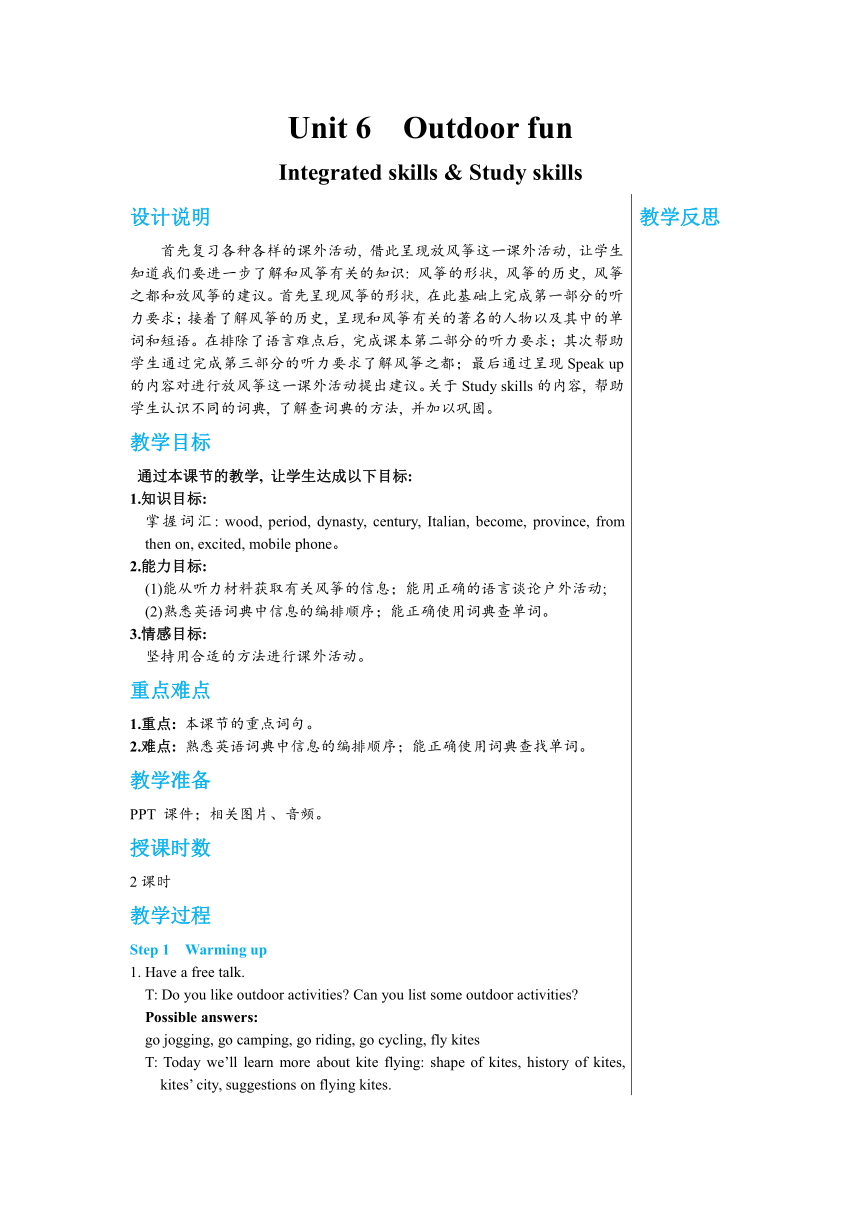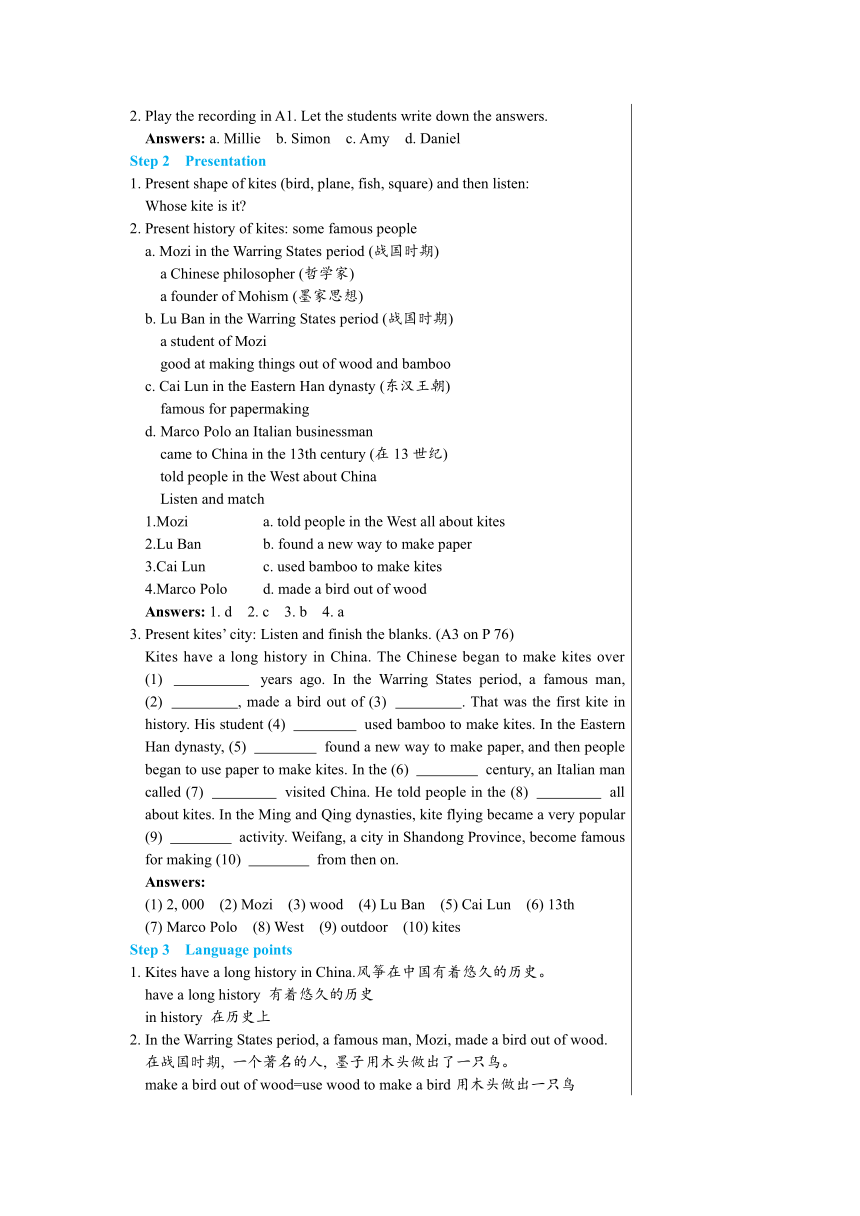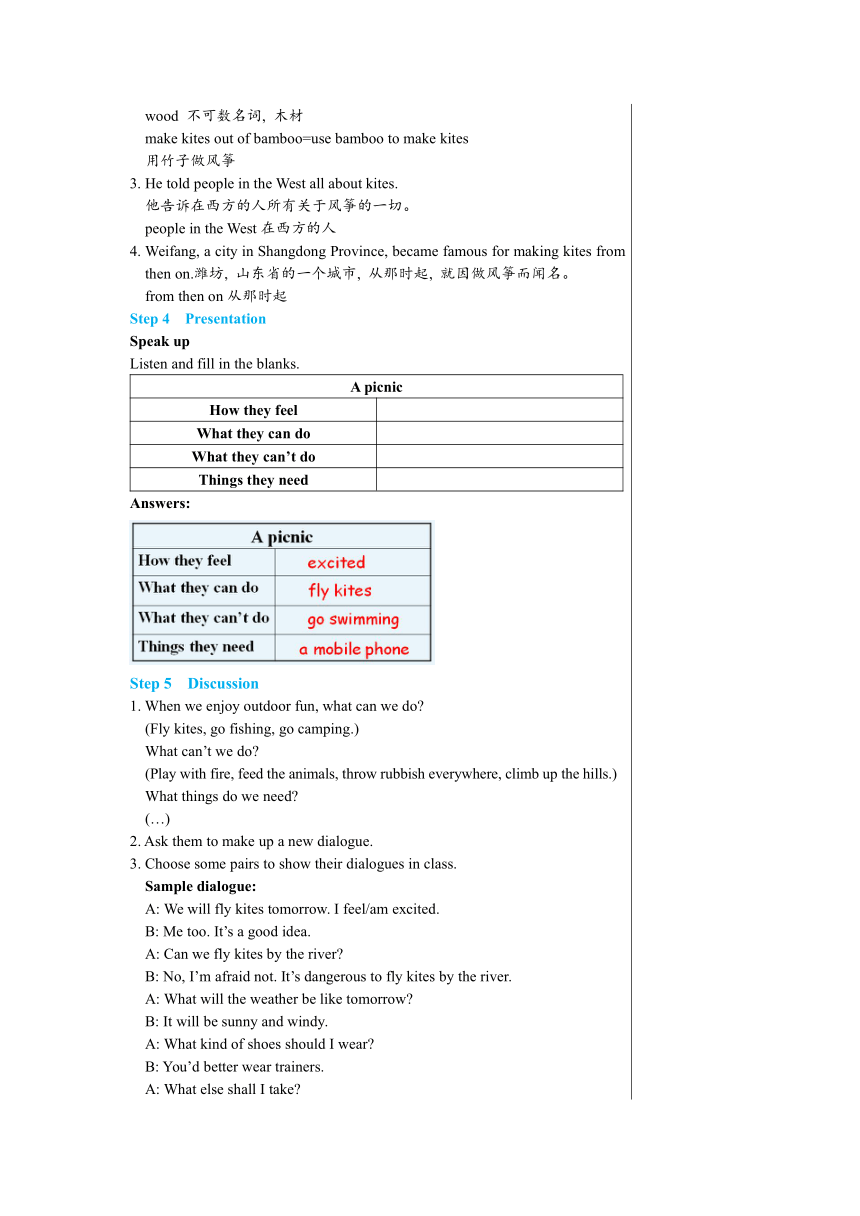Unit 6 Integrated skills & Study skills教学详案-译林牛津版初中英语七年级(下)
文档属性
| 名称 | Unit 6 Integrated skills & Study skills教学详案-译林牛津版初中英语七年级(下) |  | |
| 格式 | docx | ||
| 文件大小 | 140.6KB | ||
| 资源类型 | 试卷 | ||
| 版本资源 | 牛津译林版 | ||
| 科目 | 英语 | ||
| 更新时间 | 2024-02-21 19:45:06 | ||
图片预览



文档简介
Unit 6 Outdoor fun
Integrated skills & Study skills
设计说明 首先复习各种各样的课外活动, 借此呈现放风筝这一课外活动, 让学生知道我们要进一步了解和风筝有关的知识: 风筝的形状, 风筝的历史, 风筝之都和放风筝的建议。首先呈现风筝的形状, 在此基础上完成第一部分的听力要求;接着了解风筝的历史, 呈现和风筝有关的著名的人物以及其中的单词和短语。在排除了语言难点后, 完成课本第二部分的听力要求;其次帮助学生通过完成第三部分的听力要求了解风筝之都;最后通过呈现Speak up的内容对进行放风筝这一课外活动提出建议。关于Study skills的内容, 帮助学生认识不同的词典, 了解查词典的方法, 并加以巩固。 教学目标 通过本课节的教学, 让学生达成以下目标: 1.知识目标: 掌握词汇: wood, period, dynasty, century, Italian, become, province, from then on, excited, mobile phone。 2.能力目标: (1)能从听力材料获取有关风筝的信息;能用正确的语言谈论户外活动; (2)熟悉英语词典中信息的编排顺序;能正确使用词典查单词。 3.情感目标: 坚持用合适的方法进行课外活动。 重点难点 1.重点: 本课节的重点词句。 2.难点: 熟悉英语词典中信息的编排顺序;能正确使用词典查找单词。 教学准备 PPT 课件;相关图片、音频。 授课时数 2课时 教学过程 Step 1 Warming up 1. Have a free talk. T: Do you like outdoor activities Can you list some outdoor activities Possible answers: go jogging, go camping, go riding, go cycling, fly kites T: Today we’ll learn more about kite flying: shape of kites, history of kites, kites’ city, suggestions on flying kites. 2. Play the recording in A1. Let the students write down the answers. Answers: a. Millie b. Simon c. Amy d. Daniel Step 2 Presentation 1. Present shape of kites (bird, plane, fish, square) and then listen: Whose kite is it 2. Present history of kites: some famous people a. Mozi in the Warring States period (战国时期) a Chinese philosopher (哲学家) a founder of Mohism (墨家思想) b. Lu Ban in the Warring States period (战国时期) a student of Mozi good at making things out of wood and bamboo c. Cai Lun in the Eastern Han dynasty (东汉王朝) famous for papermaking d. Marco Polo an Italian businessman came to China in the 13th century (在13世纪) told people in the West about China Listen and match 1.Mozi a. told people in the West all about kites 2.Lu Ban b. found a new way to make paper 3.Cai Lun c. used bamboo to make kites 4.Marco Polo d. made a bird out of wood Answers: 1. d 2. c 3. b 4. a 3. Present kites’ city: Listen and finish the blanks. (A3 on P 76) Kites have a long history in China. The Chinese began to make kites over (1) years ago. In the Warring States period, a famous man, (2) , made a bird out of (3) . That was the first kite in history. His student (4) used bamboo to make kites. In the Eastern Han dynasty, (5) found a new way to make paper, and then people began to use paper to make kites. In the (6) century, an Italian man called (7) visited China. He told people in the (8) all about kites. In the Ming and Qing dynasties, kite flying became a very popular (9) activity. Weifang, a city in Shandong Province, become famous for making (10) from then on. Answers: (1) 2, 000 (2) Mozi (3) wood (4) Lu Ban (5) Cai Lun (6) 13th (7) Marco Polo (8) West (9) outdoor (10) kites Step 3 Language points 1. Kites have a long history in China.风筝在中国有着悠久的历史。 have a long history 有着悠久的历史 in history 在历史上 2. In the Warring States period, a famous man, Mozi, made a bird out of wood. 在战国时期, 一个著名的人, 墨子用木头做出了一只鸟。 make a bird out of wood=use wood to make a bird用木头做出一只鸟 wood 不可数名词, 木材 make kites out of bamboo=use bamboo to make kites 用竹子做风筝 3. He told people in the West all about kites. 他告诉在西方的人所有关于风筝的一切。 people in the West在西方的人 4. Weifang, a city in Shangdong Province, became famous for making kites from then on.潍坊, 山东省的一个城市, 从那时起, 就因做风筝而闻名。 from then on从那时起 Step 4 Presentation Speak up Listen and fill in the blanks. A picnicHow they feelWhat they can doWhat they can’t doThings they need
Answers: Step 5 Discussion 1. When we enjoy outdoor fun, what can we do (Fly kites, go fishing, go camping.) What can’t we do (Play with fire, feed the animals, throw rubbish everywhere, climb up the hills.) What things do we need (…) 2. Ask them to make up a new dialogue. 3. Choose some pairs to show their dialogues in class. Sample dialogue: A: We will fly kites tomorrow. I feel/am excited. B: Me too. It’s a good idea. A: Can we fly kites by the river B: No, I’m afraid not. It’s dangerous to fly kites by the river. A: What will the weather be like tomorrow B: It will be sunny and windy. A: What kind of shoes should I wear B: You’d better wear trainers. A: What else shall I take B: Remember to take some water/your mobile phone/sunglasses/gloves... A: OK. See you tomorrow. Step 6 Language points 1. I’m so excited.我是如此的激动。 exciting adj. 令人激动的, 说明事或物 excited adj. 激动的, 兴奋的, 说明人 The football match was very exciting.足球比赛很令人激动。 We were excited at the good news.我们听到这个好消息很激动。 2. It’s dangerous to swim in the lake. 在湖里游泳很危险。 It is+adj. +to do sth. 做某事是……的。 It is important to learn English well.学好英语很重要。 Step 7 Presentation 1. Have a guess: It can’t speak or write, but it has much knowledge. When you have problems with learning, it can give you lots of help. Answer: A dictionary 2. How to use the dictionary Choose the right dictionary: Learner’s Dictionary—thin and light, fewer words and less information Advanced Learner’s Dictionary—thick and heavy, more words and more information Study your dictionary: Dictionaries follow alphabetical order. 1. The words in a dictionary are in alphabetical order from A to Z. 2. If two words start with the same letter, we look at the second letter to look up. 3. Finish Part A on Page 77. Answers: 4. Finish Part B on Page 77. Answers: WordsPages1 pretty96-972 nothing88-893 dream34-354 neighbour84-855 earth46-47
Step 8 Homework 1. Remember the new words and the language points in this lesson. 2. Recite the dialogue. 3. Revise the use of a dictionary. 当堂达标 Ⅰ. 单项选择 1. We are very about the graduation ceremony next Saturday. We can’t wait to be there. A. boring B. bored C. excited D. exciting 2. — Do you know that girl Lucy —Sorry, I don’t know. A. calls B. to call C. calling D. called 3. — Could I go swimming with my friend, Dad —No. It’s very dangerous for you kids swimming without adults. A. go B. going C. to go D. went 4. Remember some fruit when you come back. A. buying B. to buy C. buy D. to buying 5. — My friends and I are going out for a picnic tomorrow. — A. My pleasure. B. Have a good time! C. Help yourselves. D. That’s OK. 6. — Do you believe that paper is made wood —Yes, I do. And you can see that books are made paper. A. from; from B. from; of C. of; from D. of; of 7. In a dictionary, which of the following words is before the others A. banana B. picnic C. bicycle D. forget Ⅱ. 根据句意用括号内所给单词的适当形式填空 1. — Who made the (one) kite in history — Mozi did. 2. — What is Suzhou famous for — (make) silk. 3. That old man (take) some money out of his pocket and bought some bread to eat. 4. —When was Cai Lun born —He was born in the (east) Han dynasty. 5. The little rabbit is very (love), and we all like it. 6. Are you (exciting) at the good news 7. There is a (wood) bridge over the river. 8. The Great Wall has a history of over twenty (century). 9. It’s very kind of you (help) me a lot. 10. Thank you for (invite) me to your party yesterday. Answers: Ⅰ. 1-5 CDCBB 6-7 BA Ⅱ. 1. first 2. Making 3. took 4. Eastern 5. lovely 6. excited 7. wooden 8. centuries 9. to help 10. inviting 板书设计 Unit 6 Outdoor fun Integrated skills & Study skillswood, period, dynasty, century, Italian, become, province, from then on, excited, mobile phonea. have a long history, in history b. make a bird out of wood = use wood to make a bird wood不可数名词, 木材 make kites out of bamboo = use bamboo to make kites c. from then on从那时起 d. people in the West在西方的人 e. exciting adj. 令人激动的, 说明事或物 excited adj. 激动的, 兴奋的, 说明人 f. It is +adj. +to do sth.
教学反思
Integrated skills & Study skills
设计说明 首先复习各种各样的课外活动, 借此呈现放风筝这一课外活动, 让学生知道我们要进一步了解和风筝有关的知识: 风筝的形状, 风筝的历史, 风筝之都和放风筝的建议。首先呈现风筝的形状, 在此基础上完成第一部分的听力要求;接着了解风筝的历史, 呈现和风筝有关的著名的人物以及其中的单词和短语。在排除了语言难点后, 完成课本第二部分的听力要求;其次帮助学生通过完成第三部分的听力要求了解风筝之都;最后通过呈现Speak up的内容对进行放风筝这一课外活动提出建议。关于Study skills的内容, 帮助学生认识不同的词典, 了解查词典的方法, 并加以巩固。 教学目标 通过本课节的教学, 让学生达成以下目标: 1.知识目标: 掌握词汇: wood, period, dynasty, century, Italian, become, province, from then on, excited, mobile phone。 2.能力目标: (1)能从听力材料获取有关风筝的信息;能用正确的语言谈论户外活动; (2)熟悉英语词典中信息的编排顺序;能正确使用词典查单词。 3.情感目标: 坚持用合适的方法进行课外活动。 重点难点 1.重点: 本课节的重点词句。 2.难点: 熟悉英语词典中信息的编排顺序;能正确使用词典查找单词。 教学准备 PPT 课件;相关图片、音频。 授课时数 2课时 教学过程 Step 1 Warming up 1. Have a free talk. T: Do you like outdoor activities Can you list some outdoor activities Possible answers: go jogging, go camping, go riding, go cycling, fly kites T: Today we’ll learn more about kite flying: shape of kites, history of kites, kites’ city, suggestions on flying kites. 2. Play the recording in A1. Let the students write down the answers. Answers: a. Millie b. Simon c. Amy d. Daniel Step 2 Presentation 1. Present shape of kites (bird, plane, fish, square) and then listen: Whose kite is it 2. Present history of kites: some famous people a. Mozi in the Warring States period (战国时期) a Chinese philosopher (哲学家) a founder of Mohism (墨家思想) b. Lu Ban in the Warring States period (战国时期) a student of Mozi good at making things out of wood and bamboo c. Cai Lun in the Eastern Han dynasty (东汉王朝) famous for papermaking d. Marco Polo an Italian businessman came to China in the 13th century (在13世纪) told people in the West about China Listen and match 1.Mozi a. told people in the West all about kites 2.Lu Ban b. found a new way to make paper 3.Cai Lun c. used bamboo to make kites 4.Marco Polo d. made a bird out of wood Answers: 1. d 2. c 3. b 4. a 3. Present kites’ city: Listen and finish the blanks. (A3 on P 76) Kites have a long history in China. The Chinese began to make kites over (1) years ago. In the Warring States period, a famous man, (2) , made a bird out of (3) . That was the first kite in history. His student (4) used bamboo to make kites. In the Eastern Han dynasty, (5) found a new way to make paper, and then people began to use paper to make kites. In the (6) century, an Italian man called (7) visited China. He told people in the (8) all about kites. In the Ming and Qing dynasties, kite flying became a very popular (9) activity. Weifang, a city in Shandong Province, become famous for making (10) from then on. Answers: (1) 2, 000 (2) Mozi (3) wood (4) Lu Ban (5) Cai Lun (6) 13th (7) Marco Polo (8) West (9) outdoor (10) kites Step 3 Language points 1. Kites have a long history in China.风筝在中国有着悠久的历史。 have a long history 有着悠久的历史 in history 在历史上 2. In the Warring States period, a famous man, Mozi, made a bird out of wood. 在战国时期, 一个著名的人, 墨子用木头做出了一只鸟。 make a bird out of wood=use wood to make a bird用木头做出一只鸟 wood 不可数名词, 木材 make kites out of bamboo=use bamboo to make kites 用竹子做风筝 3. He told people in the West all about kites. 他告诉在西方的人所有关于风筝的一切。 people in the West在西方的人 4. Weifang, a city in Shangdong Province, became famous for making kites from then on.潍坊, 山东省的一个城市, 从那时起, 就因做风筝而闻名。 from then on从那时起 Step 4 Presentation Speak up Listen and fill in the blanks. A picnicHow they feelWhat they can doWhat they can’t doThings they need
Answers: Step 5 Discussion 1. When we enjoy outdoor fun, what can we do (Fly kites, go fishing, go camping.) What can’t we do (Play with fire, feed the animals, throw rubbish everywhere, climb up the hills.) What things do we need (…) 2. Ask them to make up a new dialogue. 3. Choose some pairs to show their dialogues in class. Sample dialogue: A: We will fly kites tomorrow. I feel/am excited. B: Me too. It’s a good idea. A: Can we fly kites by the river B: No, I’m afraid not. It’s dangerous to fly kites by the river. A: What will the weather be like tomorrow B: It will be sunny and windy. A: What kind of shoes should I wear B: You’d better wear trainers. A: What else shall I take B: Remember to take some water/your mobile phone/sunglasses/gloves... A: OK. See you tomorrow. Step 6 Language points 1. I’m so excited.我是如此的激动。 exciting adj. 令人激动的, 说明事或物 excited adj. 激动的, 兴奋的, 说明人 The football match was very exciting.足球比赛很令人激动。 We were excited at the good news.我们听到这个好消息很激动。 2. It’s dangerous to swim in the lake. 在湖里游泳很危险。 It is+adj. +to do sth. 做某事是……的。 It is important to learn English well.学好英语很重要。 Step 7 Presentation 1. Have a guess: It can’t speak or write, but it has much knowledge. When you have problems with learning, it can give you lots of help. Answer: A dictionary 2. How to use the dictionary Choose the right dictionary: Learner’s Dictionary—thin and light, fewer words and less information Advanced Learner’s Dictionary—thick and heavy, more words and more information Study your dictionary: Dictionaries follow alphabetical order. 1. The words in a dictionary are in alphabetical order from A to Z. 2. If two words start with the same letter, we look at the second letter to look up. 3. Finish Part A on Page 77. Answers: 4. Finish Part B on Page 77. Answers: WordsPages1 pretty96-972 nothing88-893 dream34-354 neighbour84-855 earth46-47
Step 8 Homework 1. Remember the new words and the language points in this lesson. 2. Recite the dialogue. 3. Revise the use of a dictionary. 当堂达标 Ⅰ. 单项选择 1. We are very about the graduation ceremony next Saturday. We can’t wait to be there. A. boring B. bored C. excited D. exciting 2. — Do you know that girl Lucy —Sorry, I don’t know. A. calls B. to call C. calling D. called 3. — Could I go swimming with my friend, Dad —No. It’s very dangerous for you kids swimming without adults. A. go B. going C. to go D. went 4. Remember some fruit when you come back. A. buying B. to buy C. buy D. to buying 5. — My friends and I are going out for a picnic tomorrow. — A. My pleasure. B. Have a good time! C. Help yourselves. D. That’s OK. 6. — Do you believe that paper is made wood —Yes, I do. And you can see that books are made paper. A. from; from B. from; of C. of; from D. of; of 7. In a dictionary, which of the following words is before the others A. banana B. picnic C. bicycle D. forget Ⅱ. 根据句意用括号内所给单词的适当形式填空 1. — Who made the (one) kite in history — Mozi did. 2. — What is Suzhou famous for — (make) silk. 3. That old man (take) some money out of his pocket and bought some bread to eat. 4. —When was Cai Lun born —He was born in the (east) Han dynasty. 5. The little rabbit is very (love), and we all like it. 6. Are you (exciting) at the good news 7. There is a (wood) bridge over the river. 8. The Great Wall has a history of over twenty (century). 9. It’s very kind of you (help) me a lot. 10. Thank you for (invite) me to your party yesterday. Answers: Ⅰ. 1-5 CDCBB 6-7 BA Ⅱ. 1. first 2. Making 3. took 4. Eastern 5. lovely 6. excited 7. wooden 8. centuries 9. to help 10. inviting 板书设计 Unit 6 Outdoor fun Integrated skills & Study skillswood, period, dynasty, century, Italian, become, province, from then on, excited, mobile phonea. have a long history, in history b. make a bird out of wood = use wood to make a bird wood不可数名词, 木材 make kites out of bamboo = use bamboo to make kites c. from then on从那时起 d. people in the West在西方的人 e. exciting adj. 令人激动的, 说明事或物 excited adj. 激动的, 兴奋的, 说明人 f. It is +adj. +to do sth.
教学反思
